Selection of Embedding Dimension and Delay Time in Phase Space Reconstruction via Symbolic Dynamics
Abstract
1. Introduction
2. Definitions and Symbolization Procedure
Selection of p and for Finite Sample Sizes
3. Simulation Analysis
- Lorenz system [25]:The time series was obtained by projecting the x-coordinate of the system defined by the parameters a = 16, c = 45.92, b = 4, with an integral step , and initial conditions , y . The computed optimal ratio is , where is the standard deviation of the chaotic time series under consideration. For this optimal radio, Figure 1 illustrates the series of the normalized symbolic entropy as a function of the time delay for the Lorenz system. Clearly, we observe that the first local maximum is attained at and the minimum at . Then, an estimated value of embedding dimension p can be computed by solving obtaining an approximate value of . For the Mutual Information method, the optimal time delay was , while, for the C-C method, the estimated parameters were and . Notice that the optimal time delay estimated by the three methods are quite close to each other while the estimated time delay window strongly differs between C-C and symbolic methods:
- Rossler system [26]:The time series was obtained by projecting the x-coordinate of the system defined by the parameters , and , with an integral step , and initial conditions , and . The computed optimal radio is , where is the standard deviation of the chaotic time series under consideration. Figure 2 shows the normalized symbolic entropy as a function of the time delay for the Rossler system. It can be seen that the selected parameters by the symbolic method are and , and consequently the estimated value for p is 8. The estimated time delay for Mutual Information method is . For the C-C method, the estimated parameters are and . Again, the optimal time delay estimated by the three methods is very similar while the time delay window estimated by the C-C method is much different than the one estimated with symbolic entropy.
- Duffing System [27]:The time series was obtained by projecting the x-coordinate of the system defined by the parameters , , and , with an integral step , and initial conditions , y . The computed optimal radio is , where is the standard deviation of the chaotic time series under consideration. Figure 3 shows the normalized symbolic entropy as a function of the time delay for the Duffing system. The estimated optimal time delay and time delay window with the symbolic method are and , respectively. Then, the estimated embedding dimension is . As in the previous examples, the estimated time delay for the Mutual Information method () and for the C-C method () are fairly close to the one estimated by symbolic method. Again, the time delay window estimated based on the C-C method is far from the one estimated with symbolic method.These first three models are well-known and well-studied and have served as a base of comparison of new techniques for similar aims as this paper. In order to complete this analysis, we have also considered the next two models that we refer to as the Mackey–Glass model and Chen model:
- Mackey-Glass system [28]:The time series was obtained by fixing parameters a = 0;2, b = 0;1, c = 10, y = 17, with initial conditions x(t < 0) = 0 y x(t = 0) = 1;2. The first 2000 iterations were discarded. The computed optimal radio is , where is the standard deviation of the chaotic time series under consideration. The estimated optimal time delay and time delay window with the symbolic method are and , respectively. Figure 4 shows the normalized symbolic entropy as a function of the time delay for the Mackey-Glass system Then, the estimated embedding dimension is . In this case, the estimated time delay for the Mutual Information method () and for the C-C method () are fairly close to the one estimated by symbolic method (). Again, the time delay window estimated based on the C-C method is far from the one estimated with symbolic method():
- Chen system [29]:The time series was obtained by projecting the x-coordinate of the system defined by the parameters , with an integral step , and initial conditions , y . The first 2000 iterations were discarded. The computed optimal radio is , where is the standard deviation of the chaotic time series under consideration. The estimated optimal time delay and time delay window with the symbolic method are and , respectively. Figure 5 shows the normalized symbolic entropy as a function of the time delay for the Chen system. Then, the estimated embedding dimension is . As in the previous examples, the estimated time delay for the Mutual Information method () and for the C-C method () are fairly close to the one estimated by symbolic method. Again, the time delay window estimated based on the C-C method is far from the one estimated with symbolic method ().
4. EEG Dynamics under Epileptic Activity
5. Conclusions
Author Contributions
Funding
Acknowledgments
Conflicts of Interest
References
- Packard, N.H.; Crutchfield, J.P.; Farmer, J.D.; Shaw, R.S. Geometry from a time series. Phys. Rev. Lett. 1980, 45, 712. [Google Scholar] [CrossRef]
- Takens, F. Detecting Strange Attractors in Turbulence. In Dynamical Systems and Turbulence; Springer: Berlin/Heidelberg, Germany, 1981. [Google Scholar]
- Albano, A.M.; Muench, J.; Schwartz, C.; Mees, A.I.; Rapp, P.E. Singular-value decomposition and the Grassberger-Procaccia algorithm. Phys. Rev. A 1988, 38, 3017. [Google Scholar] [CrossRef]
- Fraser, A.M.; Swinney, H.L. Independent coordinates for strange attractors from mutual information. Phys. Rev. A 1986, 33, 1134. [Google Scholar] [CrossRef] [PubMed]
- Albano, A.M.; Passamante, A.; Farrell, M.E. Using high-order correlations to define an embedding window. Physica D 1991, 54, 85–97. [Google Scholar] [CrossRef]
- Pfister Buzug, T. Optimal delay time and embedding dimension for delay-time coordinates by analysis of the global static and local dynamical behavior of strange attractors. Phys. Rev. A 1992, 45, 7073–7084. [Google Scholar] [CrossRef]
- Pfister Buzug, T. Comparison of algorithms calculating optimal embedding parameters for delay time coordinates. Physica D 1992, 58, 127–137. [Google Scholar] [CrossRef]
- Rossenstein, M.T.; Colins, J.J.; de Luca, C.J. Reconstruction expansion as a geometry-based framework for choosing proper delay times. Physica D 1994, 73, 82–98. [Google Scholar] [CrossRef]
- Lin, J.; Wang, Y.; Huang, Z.; Shen, Z. Selection of proper time-delay in phase space reconstruction of speech signals. Signal Process 1999, 15, 220–225. [Google Scholar]
- Kugiumtzis, D. State space reconstruction parameters in the analysis of chaotic time series—The role of the time window length. Physica D 1996, 95, 13–28. [Google Scholar] [CrossRef]
- Kim, H.S.; Eykholt, R.; Salas, J.D. Nonlinear dynamics, delay times, and embedding windows. Physica D 1999, 127, 48–60. [Google Scholar] [CrossRef]
- Otani, M.; Jones, A. Automated Embedding and Creep Phenomenon in Chaotic Time Series. 2000. Available online: http://users.cs.cf.ac.uk/O.F.Rana/Antonia.J.Jones/UnpublishedPapers/Creep.pdf (accessed on 5 January 2021).
- Lu, J.H.; Lu, J.A.; Chen, S.H. Analysis and Application of Chaotic Time Series; Wuhan University Press: Wuhan, China, 2002. [Google Scholar]
- Matilla-Garcia, M.; Ruiz, M. Detection of nonlinear structure in time series. Econ. Lett. 2009, 105, 1–6. [Google Scholar] [CrossRef]
- Alves, J.F.; Ramos, J.S. Kneading theory: A functorial approach. Comm. Math. Phys. 1999, 204, 89–114. [Google Scholar] [CrossRef]
- Milnor, J.; Thurston, W. On iterated maps of the interval. In Dynamical Systems; Springer: Berlin/Heidelberg, Germany, 1988; Volume 1342, pp. 465–563. [Google Scholar]
- Rocha, J.L.; Ramos, J.S. Weighted kneading theory of one-dimensional maps with a hole. Int. J. Math. Math. Sci. 2004, 2004, 2019–2038. [Google Scholar] [CrossRef]
- Alves, J.F.; Ramos, J.S. Kneading theory for tree maps. Ergod. Theory Dyn. Syst. 2004, 24, 957–985. [Google Scholar] [CrossRef]
- Hao, B.; Zheng, W. Applied Symbolic Dynamics and Chaos; World Scientific: Singapore, 2003. [Google Scholar]
- Daw, C.S.; Finney, C.E.A.; Tracy, E.R. A review of symbolic analysis of experimental data. Rev. Sci. Instrum. 2003, 74, 915–930. [Google Scholar] [CrossRef]
- Matilla-Garcia, M.; Ruiz, M. A non-parametric independence test. J. Econom. 2008, 144, 39–155. [Google Scholar] [CrossRef]
- Shannon, C.E.; Weaver, W. The Mathematical Theory of Communication; University of Illinois Press: Champaign, IL, USA, 1949. [Google Scholar]
- Yibin, L.; Yong, S.; Caihong, L. Selection of parameters for Phase Space reconstruction of chaotic time series. In Proceedings of the 2010 IEEE Fifth International Conference on Bio-Inspired Computing: Theories and Applications (BIC-TA), Changsha, China, 23–26 September 2010; pp. 30–33. [Google Scholar]
- Palshikar, G. Simple algorithms for peak detection in time-series. In Proceedings of the first IIMA International Conference on Advanced Data Analysis, Business Analytics and Intelligence (ICADABAI 2009), Ahmedabad, India, 6–7 June 2009. [Google Scholar]
- Lorenz, E.N. Deterministic nonperiodic flow. Atoms J. Sci. 1963, 20, 130. [Google Scholar] [CrossRef]
- Rossler, O.E. An equation for continuous chaos. Phys. Lett. A 1976, 57, 397. [Google Scholar] [CrossRef]
- Zeni, R.A.; Gallas, J.A.C. Lyapunov Exponents for a Duffing Oscilator. Physica D 1995, 89, 79–85. [Google Scholar] [CrossRef]
- Mackey, M.; Glass, L. Oscillation and chaos in physiological control systems. Science 1977, 197, 287–289. [Google Scholar] [CrossRef]
- Lu, J.; Chen, G. A new chaotic attractor coine. Int. J. Bifurc. Chaos 2002, 12, 659–661. [Google Scholar] [CrossRef]
- Kaplan, J.; Yorke, J. Chaotic Behavior of Multidimensional Difference Equations. In Functional Differential Equations and Approximation of Fixed Points; Peitgen, H.-O., Walther, H.-O., Eds.; Springer: Berlin/Heidelberg, Germany, 1979. [Google Scholar]
- Grassberger, P.; Procaccia, I. Characterization of strange attractors. Phys. Rev. Lett. 1983, 50, 345. [Google Scholar] [CrossRef]
- Ahmed, I.; Mu, C.; Zhang, F. A New Chaotic Attractor with Quadratic Exponential nonlinear Term from Chen’s Attractor. Int. J. Anal. Appl. 2014, 5, 27–32. [Google Scholar]
- Maino, D.G.; Uzal, L.; Granito, P. Predicción de Sistemas Dinámicos con Redes Neuronales Profundas. In Proceedings of the 15th Argentine Symposium on Artifical Intelligence, Panamá, Argentina, 25–31 July 2014. [Google Scholar]
- Rosenstein, M.T.; Collins, J.J.; De Luca, C.J. A practical method for calculating largest Lyapunov exponents from small data sets. Phys. D Nonlinear Phenom. 1992, 65, 117–134. [Google Scholar] [CrossRef]
- Tang, L.; Liang, J. C-C Method to Phase Space Reconstruction Based on Multivariate Time Series. In Proceedings of the 2011 2nd International Conference on Intelligent Control and Information Processing, Harbin, China, 25–28 July 2011. [Google Scholar]
- Sprott, J.C.; Rowlands, G. Improved correlation dimension calculation. Int. J. Bifurc. Chaos 2001, 11, 1865–1880. [Google Scholar] [CrossRef]
- Hanias, M.P.; Tombras, G.S.; Nistazakis, H.E. Optoelectronic Chaotic Circuits; IntechOpen: London, UK, 2011; pp. 631–651. [Google Scholar]
- Cai, W.; Qin, Y.Q.; Yang, B.-R. Selection of Delay Time Window and Delay Time in Phase Space Reconstruction. In Proceedings of the 2007 International Conference on Computational Intelligence and Security (CIS 2007), Harbin, China, 15–19 December 2007; pp. 526–530. [Google Scholar]
- Cai, W.; Qin, Y.Q.; Yang, B.-R. Determination of Phase-Space Reconstruction Parameters of chaotic time series. Kybernetika 2008, 44, 557–570. [Google Scholar]
- Xiu, C.B.; Liu, X.D.; Zhang, Y.H. Selection of embedding dimension and delay time in the phase space reconstruction. Trans. Beijing Inst. Technol. 2003, 23, 219–224. [Google Scholar]
- Andrzejak, R.G.; Lehnertz, K.; Rieke, C.; Mormann, F.; David, P.; Elger, C.E. Indications of nonlinear deterministic and finite dimensional structures in time series of brain electrical activity: Dependence on recording region and brain state. Phys. Rev. E 2001, 64, 061907. [Google Scholar] [CrossRef]
- Babloyantz, A.; Destexhe, A. Low-dimensional chaos in an instance of epilepsy. Proc. Natl. Ncad. Sci. USA 1986, 83, 3513–3517. [Google Scholar] [CrossRef]
- Pritchard, W.S.; Duke, D.W. Measuring chaos in the brain: A tutorial review of EEG dimension estimation. Brain Cogn. 1995, 27, 353–397. [Google Scholar] [CrossRef] [PubMed]
- Elger, C.E.; Widman, G.; Andrzejak, R.; Arnhold, J.; David, P.; Lehnertz, K. Nonlinear EEG analysis and its potential role in epileptology. Epilepsia 2000, 41, 34–38. [Google Scholar] [CrossRef]
- Theiler, J.; Eubank, S.; Longtin, A.; Galdrikian, B. Testing for Nonlinearity in Time Series: The Method of Surrogate Data. Physica D 1992, 58, 77–94. [Google Scholar] [CrossRef]
- BenSaïda, A. A practical test for noisy chaotic dynamics. SoftwareX 2015, 3, 1–5. [Google Scholar] [CrossRef]
- Theiler, J. Some comments on the correlations dimensions of 1/f a noise. Phys. Lett. A 1991, 155, 480–493. [Google Scholar] [CrossRef]
- Casdagli, M.C.; Iasemidis, L.D.; Savit, R.S.; Gilmore, R.L.; Roper, S.; Sackellares, J.C. Nonlinearity in invasive EEG recordings from patients with temporal lobe epilepsy. Electroencephalogr. Clin. Neurophysiol. 1997, 102, 98. [Google Scholar] [CrossRef]
- Pijn, J.P.M.; Velis, D.N.; van der Heyden, M.J.; DeGoedde, J.; van Veelen, C.; Lopes da Silva, F.H. Nonlinear dynamics of epileptic seizures on basis of intracranial EEG recordings. Brain Topogr. 1997, 9, 249. [Google Scholar] [CrossRef]
- Kannathal, N.; Acharya, U.R.; Lim, C.M.; Sadasivan, P.K. Characterization of EEG—A comparative study. Comput. Methods Programs Biomed. 2005, 80, 17–23. [Google Scholar] [CrossRef]
- Yao, W.; Wang, J. Multi-scale symbolic transfer entropy analysis of EEG. Phys. A Stat. Mech. Its Appl. 2017, 484, 276–281. [Google Scholar] [CrossRef]
- Hussain, L.; Aziz, W.; Alowibdi, J.S.; Habib, N.; Rafique, M.; Saeed, S.; Kazmi, S.Z.H. Symbolic time series analysis of electroencephalographic (EEG) epileptic seizure and brain dynamics with eye-open and eye-closed subjects during resting states. J. Physiol. Anthropol. 2017, 36, 21. [Google Scholar] [CrossRef]
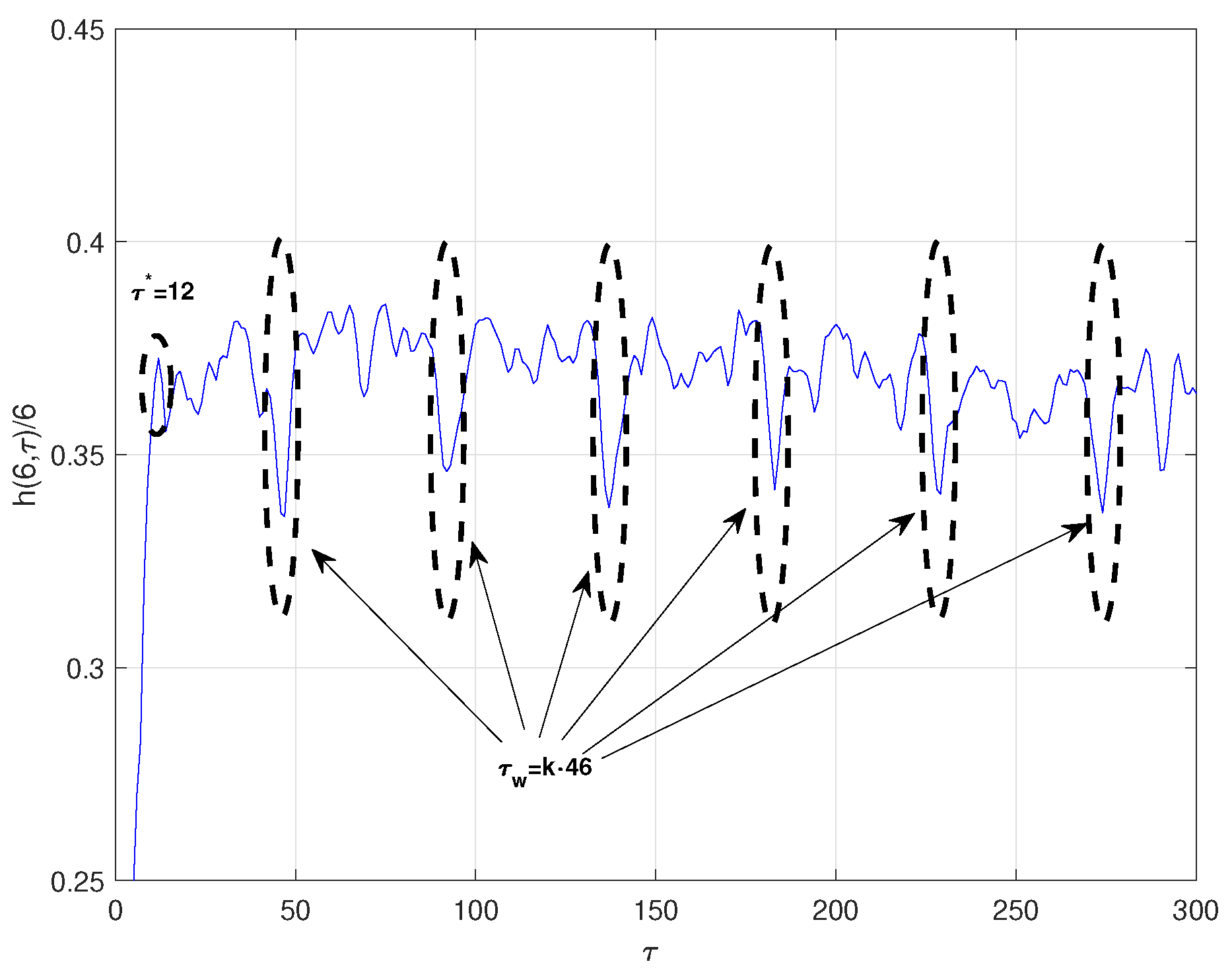
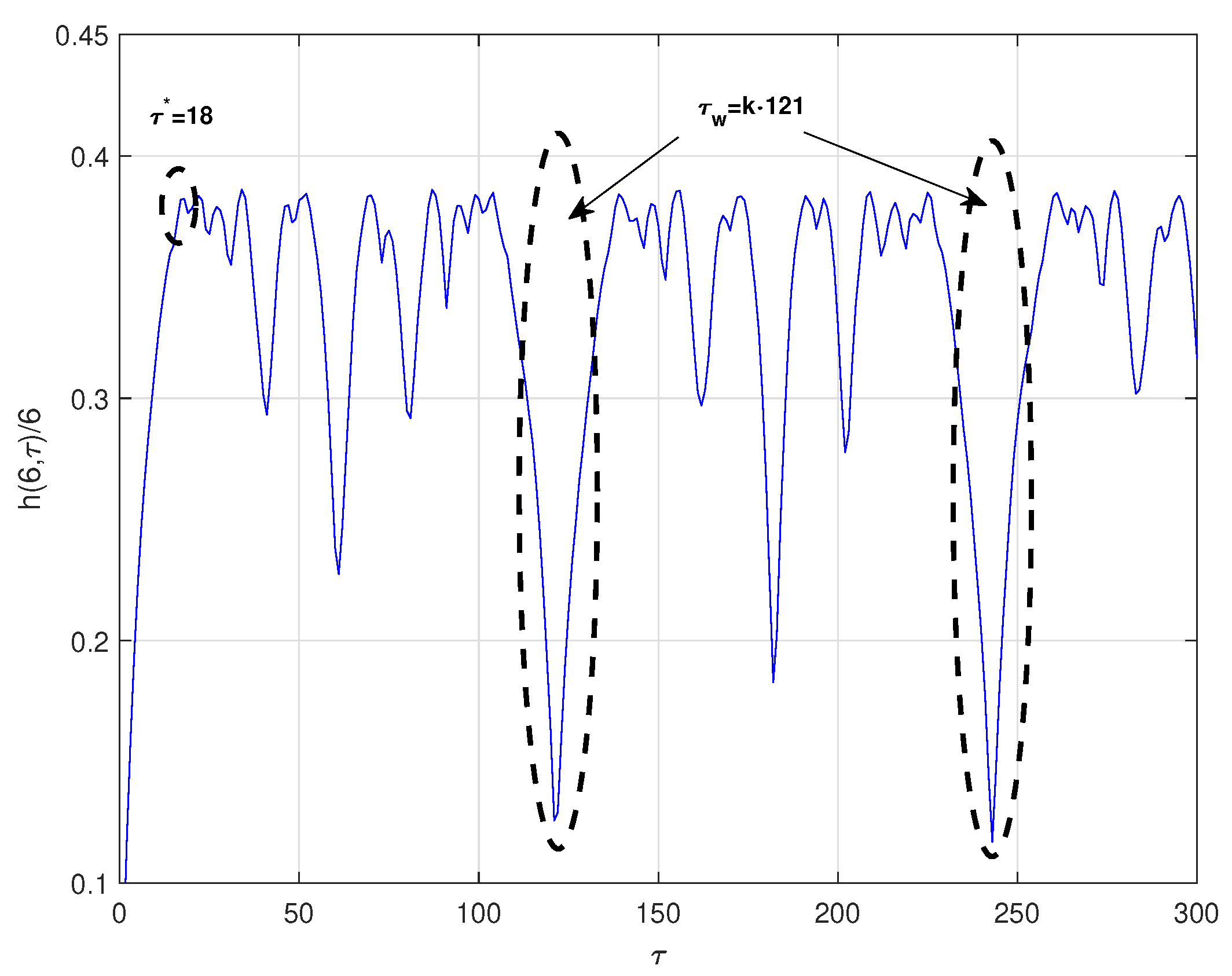
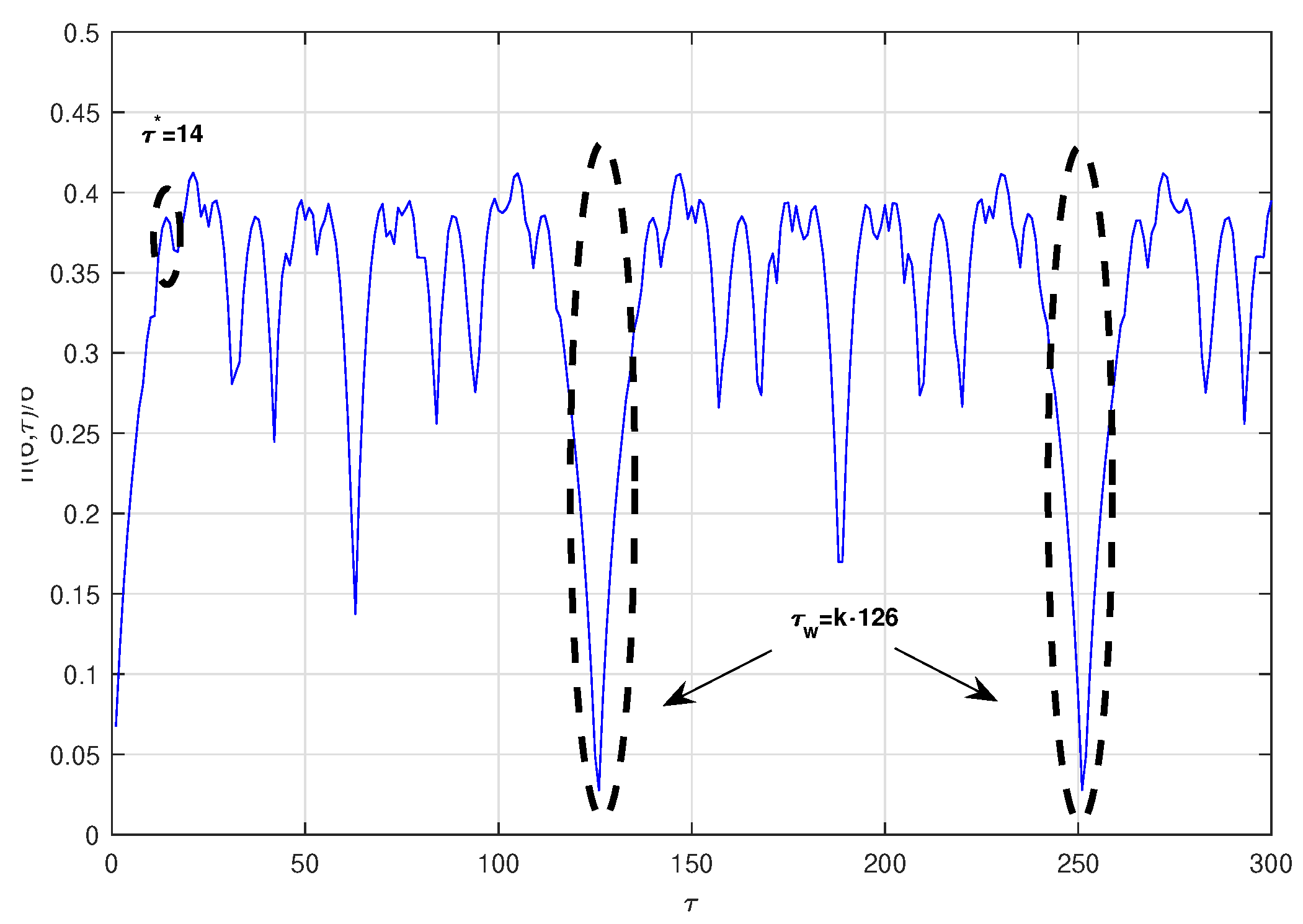
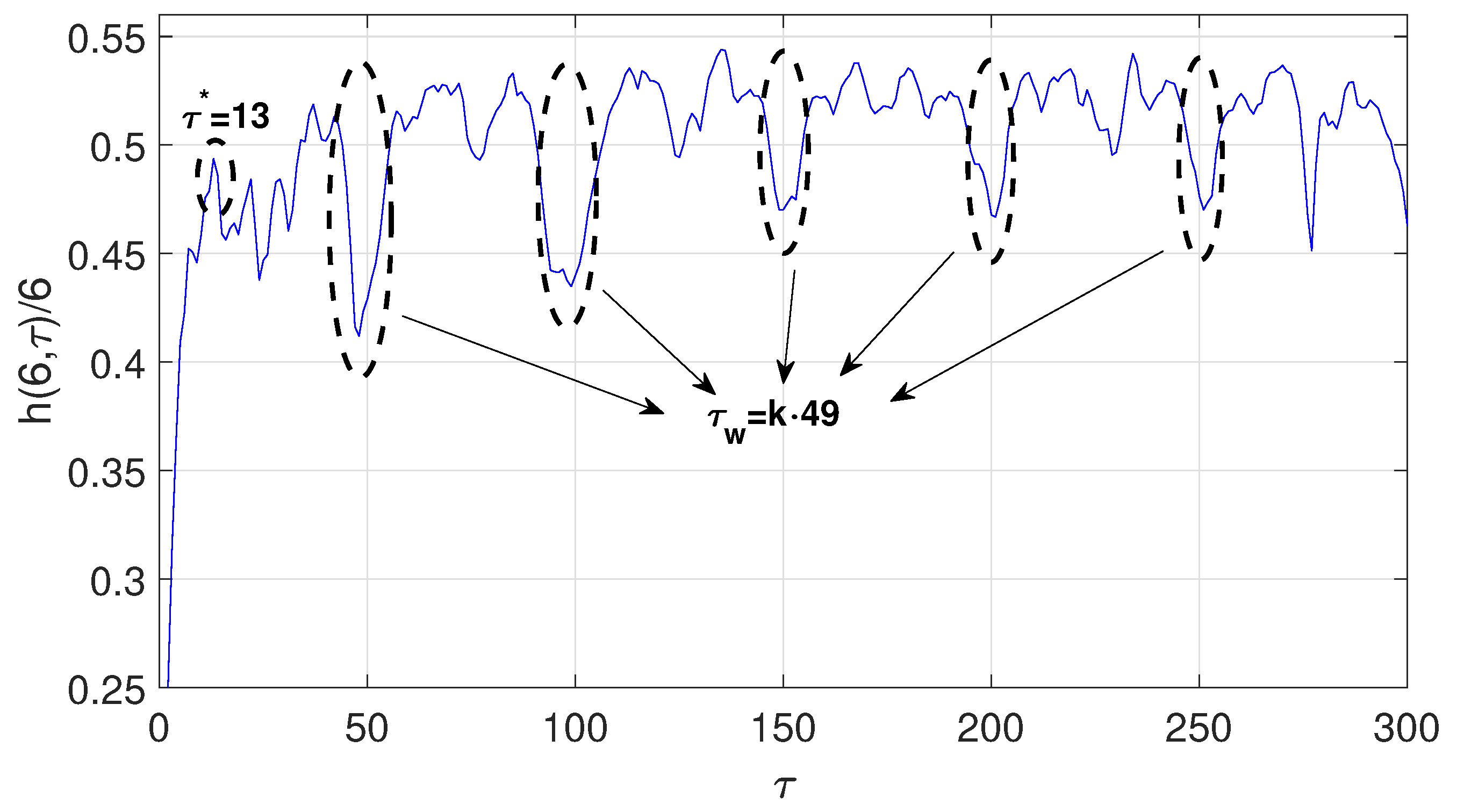
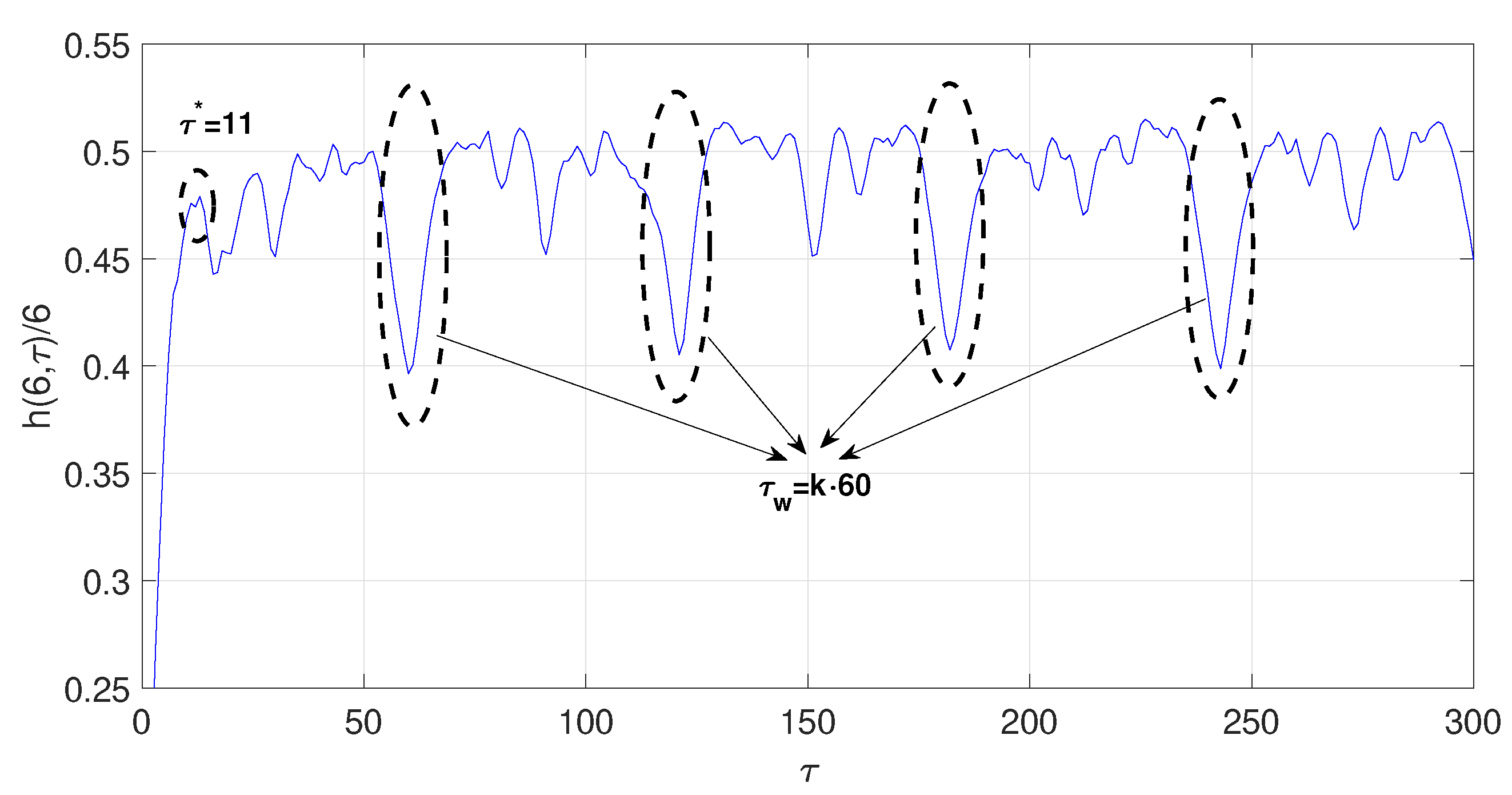
| MI Method | C-C Method | Symbolic Method | NN | FAC | |||||||
|---|---|---|---|---|---|---|---|---|---|---|---|
| System | p | p | p | p | |||||||
| Lorenz | 11 | 10 | 100 | 11 | 12 | 46 | 5 | 11 | 3 | 11 | 3 |
| Rossler | 20 | 17 | 191 | 12 | 18 | 121 | 8 | 20 | 4 | 20 | 4 |
| Duffing | 12 | 14 | 161 | 12 | 14 | 126 | 10 | 12 | 2 | 12 | 2 |
| Mc-Glass | 12 | 14 | 166 | 13 | 13 | 49 | 5 | 12 | 4 | 12 | 4 |
| Chen | 10 | 9 | 104 | 27 | 11 | 60 | 6 | 10 | 4 | 10 | 4 |
| LLE Reference Value | Estimated LLE C-C Method | Estimated LLE Symbolic Method | Estimated LLE NN | Estimated LLE FAC | |
|---|---|---|---|---|---|
| Lorenz | 1.500 | 0.940 (1.667) | 1.50 (1.670) | 1.438 (1.659) | 0.771 (0.742) |
| Rossler | 0.090 | 0.095 (0.066) | 0.09 (0.080) | 0.061 (0.079) | 1.108 (0.068) |
| Duffing | 0.183 | 0.168 (0.021) | 0.184 (0.200) | 0.014 (0.215) | 0.019 (0.02) |
| Mc-Glass | 0.007 | 0.006 (0.008) | 0.007 (0.007) | 0.006 (0.009) | 0.007 (0.008) |
| Chen | 1.997 | 1.852 (1.773) | 1.982 (1.852) | 2.483 (2.160) | 1.359 (1.120) |
Reference Value | Estimated C-C Method | Estimated Symbolic Method | Estimated NN | Estimated FAC | |
|---|---|---|---|---|---|
| Lorenz | 2.06 | 1.93 (2.41) | 2.01 (2.02) | 1.76 (2.23) | 2.02 (3.63) |
| Rossler | 2.01 | 2.13 (2.31) | 2.09 (2.01) | 1.79 (1.77) | 1.92 (1.49) |
| Duffing | 2.23 | 2.10 (2.56) | 2.21 (2.37) | 1.13 (1.16) | 1.51 (1.47) |
| Mc-Glass | 2.10 | 2.83 (2.20) | 2.12 (2.11) | 1.94 (1.80) | 2.01 (1.97) |
| Chen | 2.16 | 2.19 (3.67) | 2.13 (2.12) | 2.05 (2.26) | 2.36 (3.49) |
| Brain Status | p | Non Linearity Test | Chaos vs. Stochastic | Estimated | ||
|---|---|---|---|---|---|---|
| Healthy with open eyes | 13 | 98 | 9 | NL | Stochastic | 5.56 |
| Healthy with closed eyes | 9 | 109 | 13 | L | - | 7.98 |
| Seizure free non-epileptogenic zone | 9 | 120 | 14 | L | - | 4.99 |
| Seizure free epileptogenic zone | 18 | 108 | 7 | NL | Chaos | 3.48 |
| Seizure activity | 11 | 65 | 7 | NL | Chaos | 3.69 |
Publisher’s Note: MDPI stays neutral with regard to jurisdictional claims in published maps and institutional affiliations. |
© 2021 by the authors. Licensee MDPI, Basel, Switzerland. This article is an open access article distributed under the terms and conditions of the Creative Commons Attribution (CC BY) license (http://creativecommons.org/licenses/by/4.0/).
Share and Cite
Matilla-García, M.; Morales, I.; Rodríguez, J.M.; Ruiz Marín, M. Selection of Embedding Dimension and Delay Time in Phase Space Reconstruction via Symbolic Dynamics. Entropy 2021, 23, 221. https://doi.org/10.3390/e23020221
Matilla-García M, Morales I, Rodríguez JM, Ruiz Marín M. Selection of Embedding Dimension and Delay Time in Phase Space Reconstruction via Symbolic Dynamics. Entropy. 2021; 23(2):221. https://doi.org/10.3390/e23020221
Chicago/Turabian StyleMatilla-García, Mariano, Isidro Morales, Jose Miguel Rodríguez, and Manuel Ruiz Marín. 2021. "Selection of Embedding Dimension and Delay Time in Phase Space Reconstruction via Symbolic Dynamics" Entropy 23, no. 2: 221. https://doi.org/10.3390/e23020221
APA StyleMatilla-García, M., Morales, I., Rodríguez, J. M., & Ruiz Marín, M. (2021). Selection of Embedding Dimension and Delay Time in Phase Space Reconstruction via Symbolic Dynamics. Entropy, 23(2), 221. https://doi.org/10.3390/e23020221






